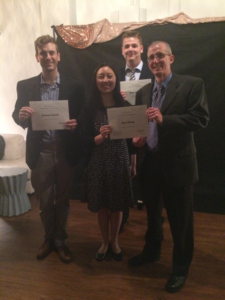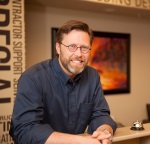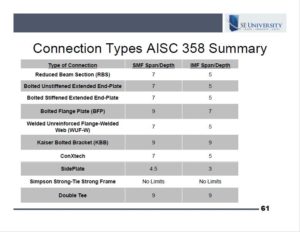26 Oct / 2017
“SEU Speaker Inspires” Organization of the Month: Habitat for Humanity – Capital District
In October 2017, Otto Schwarz, PE, SE, from Ryan Biggs | Clark Davis, gave a talk on Post-Tensioned Concrete Analysis and Design. He chose the Habitat for Humanity – Capital District (https://www.habitatcd.org/) for the SEU Speaker Inspires donation of the month.
Otto shared why he chose his local Habitat for Humanity: “I have been lucky enough to have the privilege of having a stable place to call home and the security of knowing that there was a place I could go to be safe and warm, and to prepare for each new day. This may not be the reason for my successes in life, but without it, I could have never made it this far. The ability to thrive and succeed in life requires a stable foundation on which to build, and many do not have that basic need satisfied. Habitat for Humanity fills this need for so many with the help of the work and donations of so many more.”
Thank you, Otto, for helping structural engineers with your SE University session, and for your designation of Habitat for Humanity – Capital District as our SEU Speaker Inspires Organizations of the Month!
25 Sep / 2017
SE Solutions Provides Scholarships to 3 MSCE Structures Students from Purdue University (2017)
SE Solutions was pleased to recently present scholarships to three Purdue University Structures students to help defray the cost of their education. Máté Opoldusz, William Pollalis, and April Wang were the recipients of the awards. This is the sixth year that SE Solutions has offered the scholarships.

Purdue University MSCE Students and Scholarship Winners William Pollalis (left), April Wang (middle), Máté Opoldusz (back), and SE Solutions, LLC President, Brian Quinn
Máté Opoldusz received his BS degree in civil engineering from Budapest University of Technology and Economics in Hungary. He completed his MS in Structural Engineering at Budapest University of Technology and Economics in June 2017, where he conducted research into the design method development of seismic resistant rocking structures. He received a Fulbright Scholarship for 2016-2017 academic year to pursue MSCE at Purdue and he is planning to graduate in December 2017. Máté is working as a Graduate Teaching Assistant for the reinforced concrete design class. Upon his graduation, he hopes to find work at a structural engineering firm near California doing building design.
William Pollalis received his BS in Civil engineering from Purdue and will be completing his MSCE this December (2017). He then plans to continue at Purdue, pursuing a PhD. He is currently conducting research on lap splices in reinforced concrete shear walls susceptible to seismic events.
April Y. Wang received her BS in Civil Engineering from Purdue in 2016, and will complete her MSCE at Purdue in May 2018. She is currently working as a graduate research assistant focusing on the behavior and design of concrete-filled composite plate shear walls (CF-CPSW) for use in high-rise buildings, a project sponsored by AISC and the Charles Pankow Foundation. As a high school student, April enjoyed how physics could explain observable phenomena, but wanted to apply physics to leave a lasting, beneficial impact on society. She was drawn to structural engineering because buildings and bridges are beautiful, lasting solutions to the needs of communities, and they can only exist due to the structure behind the aesthetic finishes. April hopes to join a structural engineering firm after graduation and create beautiful solutions.
SE Solutions would like to congratulate each recipient and wish them future success in their fields of study as structural engineers.
21 Sep / 2017
Disaster Relief – Engineers Can Help!
Our natural response to seeing our fellow Americans suffering through a natural disaster is, “How can I help?” But sometimes, that is about as far as we get. We might donate a few dollars to the Red Cross, or a religious organization that specializes in disaster relief, but we as structural engineers are uniquely equipped to be of help during disaster relief.
Recently, the National Council of Structural Engineers Associations website published How Structural Engineers Can Assist in Natural Disaster Relief Efforts. This page includes information on how you can be a part of future disaster relief efforts, and provides ways to keep up to date with specialized training seminars, including free webinars from the Applied Technology Council on the ATC-45 Field Manual: Safety Evaluation on Buildings after Windstorms. The Structural Engineer Emergency Response (SEER) Committee is active in the recovery efforts in Texas and Florida, and you could be positioned to help with the next crisis that may come our way.
Engineers seeking to help with the relief efforts in Texas can apply for a temporary emergency license by visiting the Texas Board of Professional Engineers’ website. Also, the National Science Foundation is encouraging submissions of proposals seeking to address the changes related to Hurricane Harvey.
Additionally, the National Voluntary Organizations Active in Disaster (VOAD) is a collective organization which draws together various groups who specialize in disaster response. These organizations are able to quickly mobilize and provide relief to individuals affected by these disasters. Different organization are active in different parts of the country, so check out their websites to see how you can volunteer through your local chapters or donate necessary supplies.
In August 2017, Ash Norton, from Ash Norton Engineering Leadership, gave a talk on Digital Presence for Engineers: What are Your Emails Really Saying? She chose the Kentucky Educational Television (https://www.ket.org/) for the SEU Speaker Inspires donation of the month.
Ash shared why she chose Kentucky Educational Television: “Some of my earliest memories were of watching Sesame Street and other programs on the local public broadcasting station – KET Kentucky Educational Television. Growing up in a poor family from Kentucky, my future was uncertain. However, the high-quality, educational programming that KET provided instilled in me an early love of learning.
This love of learning allowed me to excel in academics – graduating from high school a year early and ultimately earning degrees in chemical engineering and masters of business administration.
Now KET’s programming is diverse and innovative, while still maintaining commitment to its values of Learning, Excellence,and Community.”
Thank you, Ash, for helping structural engineers with your SE University session, and for your designation of Kentucky Educational Television as our SEU Speaker Inspires Organization of the Month!
24 Aug / 2017
Tips for Improving your Email Communication
Have you given much thought as to how your clients and co-workers might describe communicating with you? Are you aware that each email you send makes a statement about your reputation as an engineer? Email has become the most used form of communication, and whether you are managing a project through email, or building new business relationships, every email is a reflection of your personal brand.
In August 2017, Ash Norton, from Ash Norton Leadership, presented Digital Presence for Engineers: What are Your Emails Really Saying? for SE University. Ash spoke about how our emails contribute to our personal brand or reputation whether we intend them to or not. Also, Ash spoke about how emails can be misinterpreted without tone and body language to help define their intent, so we must be very intentional in our choice of words.
Ash gave some great pointers to improve our daily communication via email:
| Do: | Don’t: |
| Match formality to relationship and desired digital presence | Use negative words |
| Use one topic subject lines | Use text speak |
| Minimize interpretation opportunities | Overuse punctuation |
| Include a clear call to action | Use all caps |
| Proofread | Use email to convey emotion |
| Recognize that it is a record | Use email to manage conflict |
| Attempt sarcasm or humor |
Overall, taking the time to consider how our emails reflect our reputation within the engineering community is a worthwhile endeavor and can lead to better receptivity of your message. Before you hit send, reconsider how the email might be perceived and strive to enhance your reputation and professionalism.
Special moment frame design can be daunting for the engineer that is not completely familiar with the many code provisions that ensure they can withstand high seismic activity. Even the most seasoned seismic designers can benefit by reviewing the additional design and detailing requirements occasionally to be sure nothing is missed when designing these highly complex frame systems and connections.
In June 2017, Matt Mester, PE, SE from SidePlate Systems, Inc. presented Moment Frames: Design and Detailing per AISC 341 and 358 for SE University. His presentation included moment frame and connection design principles, and he compared and contrasted the various code requirements for each type of moment frame. Matt also reviewed the use of prequalified moment connections from AISC 358.
During his presentation, Matt referenced the NEHRP Seismic Design Technical Brief No. 2. This brief specifically addresses the design and detailing of special moment frames and their connections to ensure they can safely withstand severe earthquake shaking while experiencing substantial inelastic deformation. Included in the brief are analysis and design guidance, additional requirements, and detailing and constructability issues. This more in depth discussion on special moment frames is a great reference for engineers that typically practice in high seismic zones and for engineers that may just be getting started in the design of special moment frames.
17 Aug / 2017
“SEU Speaker Inspires” Organization of the Month: Structural Engineers Association of Utah Scholarship Program
In July 2017, Kimberley Robinson, PE, SE, from SunSteel, LLC, gave a talk on Buckling Restrained Braced Frames. She chose the Structural Engineers Association of Utah Scholarship Program (http://www.seau.org/) for the SEU Speaker Inspires donation of the month.
Kim designated the same organization after her December 2016 SE University session, and she shared then why she chose the SEAU Scholarship Program: “I think that it is very important to support young and talented would-be engineers and bring them closer to their goal of a college degree and a rich and rewarding career.”
Thank you, Kim, for helping structural engineers with your SE University session, and for your designation of the SEAU Scholarship Program as our SEU Speaker Inspires Organization of the Month!
19 Jul / 2017
AISC 358 Connection Types and Limits
Connection design can get complicated when a building is located in a high seismic region. These connections require a significant amount of inelastic deformation in order to safely resist strong seismic activity. After the Northridge earthquake in 1994, many connection failures found in the aftermath allowed code officials to investigate and make changes to prevent these types of failures from recurring. One of the many results from this incident was the eventual development of the prequalified moment connections contained in AISC 358.
In June 2017, Matt Mester, PE, SE from SidePlate Systems, Inc. presented Moment Frames: Design and Detailing per AISC 341 and 358 for SE University. Matt reviewed all of the prequalified moment connections contained in AISC 358 and discussed the restrictions and limitations for when these connections can be used. He presented several useful charts which show each connection type included in AISC 358. Click on the slide below to access the 4 page file so that you can create your own quick reference chart for future seismic connection design.
13 Jul / 2017
“SEU Speaker Inspires” Organization of the Month: Structural Engineers Association of Southern California Foundation
In June 2017, Matthew Mester, PE, SE, from SidePlate Systems, Inc., presented Moment Frames: Design and Detailing per AISC 341 and 358. He nominated the Structural Engineers Association of Southern California Foundation (http://www.seaosc.org) for the SEU Speaker Inspires donation of the month.
The Structural Engineers Association of Southern California Foundation, in its goals to further the development of the structural engineering profession, looks for partners, be it individuals, companies or corporations, to pursue structural engineering innovation and research for use in the public domain. The foundation can assist in the development process of specific structural engineering research projects and publishing of any findings.
The foundation is dependent upon donations for its operation and funding of research projects and annual student scholarships. Matthew chose to donate to the SEAOSC Foundation for student scholarships to “help the next generation of structural engineers.”
Thank you, Matthew, for helping structural engineers with your SE University session, and for your designation of the Structural Engineers Association of Southern California Foundation as our SEU Speaker Inspires Organization of the Month!
SE University began the SEU Speaker Inspires program in 2015 as a way to “pay it forward”, enabling our speakers to designate a charity/organization of their choice for SE University to make a donation to help improve our world.
23 Jun / 2017
Overcoming Mistakes at Work
I think we can all agree, everyone makes mistakes. But how we deal with mistakes can greatly influence our success at work and in life. As Mark Twain once said, “Good judgement is the result of experience and experience the result of bad judgement.” So, how then are we to handle our mistakes in a way that nurtures self-growth, rather than self-doubt?
Here are three steps toward moving past mistakes in the workplace:
- Be honest with yourself and your supervisor. Admit your mistake and take responsibility. Although we all hate to admit we were wrong, making excuses or blaming others impedes our ability to learn from the mistake.
- Make amends. Do your best to help fix the problem; taking the initiative of responsibility will help to show your willingness to completing a successful project.
- Move on. Dwelling on past mistakes will lead to a fear to act on new opportunities.
Though it may be a rough season to walk through, learning from mistakes can lead to growth and better decision making in the future. I once worked with a senior engineer who had missed checking some roof trusses for uplift, and only realized their mistake as the building was being constructed. Rather than cover their tracks, the engineer graciously shared their misdeed with the younger engineers so that we might learn from their mistake, and avoid one of our own. Honesty and humility can go a long way toward repairing any mistake you might have committed, and may gain you some respect from your colleagues.






